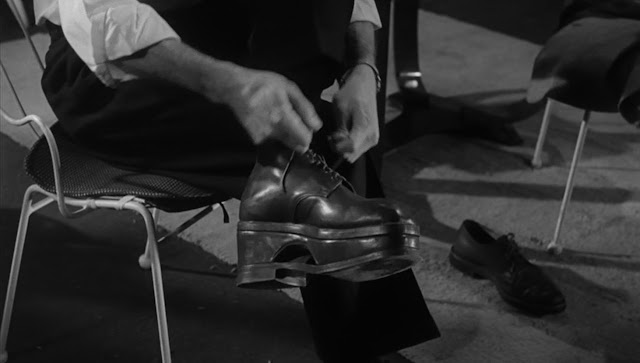Nowhere to Go (1958)
 |
| George Nader |
Nowhere to Go was the penultimate film made by Ealing Studios (although by 1958 when this was released the company had left Ealing and was working under the name Ealing Films).
 |
| The company logo as seen in the opening credits |
The only result of a brief period in which the legendary film critic Kenneth Tynan worked as a script editor for the company, it's a stunning departure from much of the company's earlier output. Dark, bleak and with no sympathetic characters, it's the Ealing film for people who don't like Ealing films.
Nowhere to Go is a slice of British film noir that easily stands comparison with more lauded examples of the genre such as: Night and the City, It Always Rains on Sunday, or Hell is a City. It tells the story of Paul Gregory (played by George Nader) a London-based Canadian criminal who steals £55,000 from a wealthy widow, hides the money and allows himself to be caught so that he can safely retrieve the money after he is freed from prison. Everything goes wrong after he is sentenced to ten years rather than the three years he expected. Forced to break out from prison he is soon double crossed by his partner in crime (played by Bernard Lee) ...
 |
| Bernard Lee |
... and soon finds himself trapped with no friends and no support from the criminal community.
For assistance he turns to Bridget Howard (played by 24 year old Maggie Smith in her first credited film role) whose runaway boyfriend's flat Gregory is staying in. Though seemingly innocent, Smith's character is another lost soul who admits to having frequently run away from schools, hasn't seen her family for years and whose banker boyfriend has fled to Tangiers after an embarrassing court appearance. Despite this seeming innocence, she happily assists the fugitive by driving him out of London to hide him near her family home in Wales.
 |
| Maggie Smith |
 |
| Maggie Smith & George Nader |
The film is skilfully directed by Seth Holt who gives the film a claustrophobic feel: The fugitive Gregory is shown to be trapped at every turn. At the start of the film he is in a prison cell and yet even after his escape he can find no freedom. First he is confined to a flat ...
 |
| Bernard Lee & George Nader |
 |
| Bernard Lee & George Nader |
... where even the shadows are reminiscent of bars. Then he goes to the retrieve the money from his safe deposit box ...
 |
| George Nader |
but bars once again keep him away from his money (and his only hope of escape). Even in the flashback when he steals the money he has to visit an office with barred windows ...
... we repeatedly see him in cars ...
... and telephone boxes.
The notion that he cannot escape is reinforced by his choice of disguise: a built up shoe that makes him appear to be a cripple. As he tells Lee, it's the perfect disguise since "No one ever looks a cripple in the eye."
The symbolism is rather simple: with such as shoe there truly is Nowhere to Go. The shoe he has abandoned is the shoe to make an escape. He chooses something that can only hold him back.
The image is reinforced at the film's close ...
... when we see a pair of feet in wellington boots, deep in mud: Gregory is stuck in the mud with Nowhere to Go.
As the film closes we see Maggie Smith walking across a bleak landscape. This is no rural idyll, but a rough land with smoke-belching chimneys in the distance - as if to symbolise the city Paul Gregory was unable to escape from.
 |
| Maggie Smith |
This is no Titfield Thunderbolt or any other of Ealing's supposed cosy depictions of British life. It is hardly even close to It Always Rains On Sunday, Ealing's critically acclaimed slice of British Noir. Whilst It Always Rains on Sunday is a gritty crime drama, it retains a deep sense of urban community - similar to that seen in such films as 'Hue & Cry' or 'Passport to Pimlico'. Yet Nowhere to Go abandons any pretence of community. Everyone is rotten: George Nader is a rotten conman who targets a widow; Lee betrays his partner; Smith only helps Nader because her own life is so empty and directionless. Even the crime boss (played by Harry H. Corbett in only his second screen appearance) refuses to assist him for fear of the retribution it might bring down on him.
 |
| Harry H. Corbett |
The film was hardly a success. Their reaction was understandable. But if audiences were unsympathetic, history is a better judge and the film is a strong depiction of a wasted life. As previously noted:
Nowhere to Go is the least Ealing of all Ealing films and the perfect film to show anyone who dares to say they dislike Ealing Studios for its cosy portrayal of British life. So there!
****************************************************
On a side point: also appearing in the film are two stalwarts of 1950s British cinema, Glyn Houston and Lionel Jeffries:
 |
| Glyn Houston |
 |
| Lionel Jeffries |






No comments:
Post a Comment